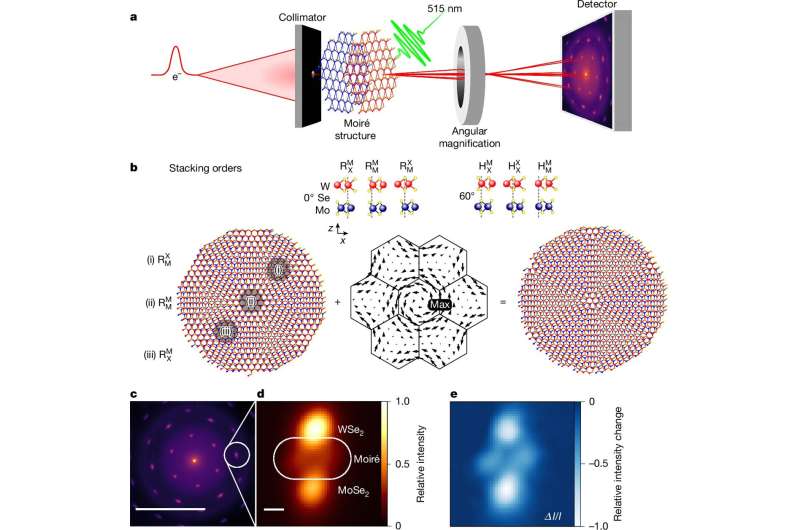Science
Researchers Capture Atomic Motion with Light in Real Time

A groundbreaking study reveals how atomic layers in materials respond to light, showcasing a dynamic twisting motion that occurs in a trillionth of a second. Researchers from Cornell University and Stanford University utilized ultrafast electron diffraction to capture this atomic choreography, which is set in motion by precisely timed bursts of energy. The findings, published in Nature on November 12, 2025, provide new insights into the manipulation of moiré materials—stacked two-dimensional structures whose unique properties change with slight twists.
Atoms in a crystalline sheet just a few layers thick begin to move in a coordinated rhythm when exposed to light, resembling dancers synchronizing to a beat. This study marks a significant advancement in understanding how light can dynamically manipulate material behavior. Researchers had not previously been able to observe the physical response of these layers to light bursts.
Jared Maxson, a professor of physics at Cornell and co-corresponding author of the study, explained the implications: “People have long known that by stacking and twisting these atomically thin layers, you can change how a material behaves. You can turn it into a superconductor or make electrons act in strange new ways. What’s new here is that we enhance that twist dynamically with light, and actually watch it happen in real time.”
The team demonstrated that the atomic layers could twist tightly together and then spring back, akin to a coiled ribbon releasing energy. This observation contradicts previous assumptions that once these moiré materials were stacked at a fixed angle, they remained static. Co-corresponding author Fang Liu, project lead at Stanford, stated, “What we have shown is that it is definitely not fixed at all—the atoms will move. In fact, the atoms inside each moiré unit cell will do a kind of circle dance.”
To capture this fleeting atomic motion, the researchers employed a specialized ultrafast electron diffraction instrument developed in Maxson’s lab. This device fires intense bursts of electrons at a sample immediately after it is struck by a laser pulse, enabling them to observe atomic shifts over time. A crucial element of the experiment was the Electron Microscope Pixel Array Detector (EMPAD), a high-speed, ultra-sensitive detector designed at Cornell. Originally intended for still images, the EMPAD functioned as a hypersensitive movie camera for atoms, allowing the team to capture subtle features that might have been lost with other detectors.
Maxson remarked on the significance of collaboration in this research, stating, “There’s no way we could have witnessed this phenomenon without combining materials understanding with electron-beam understanding.” Liu’s lab provided the specially engineered moiré materials essential for the study.
Moreover, Aaron Lindenberg, a professor of materials sciences at Stanford, contributed critical insights into the data analysis. The data collection was spearheaded by Cameron J. R. Duncan, a doctoral student in Maxson’s group, who played a key role in reconstructing atomic motion from complex diffraction patterns. Duncan expressed satisfaction at the outcome, noting, “We were the first to succeed in finding the ultrafast moiré signal because we customized our home-built hardware specifically to enhance its diffraction-resolving power.”
Looking ahead, Liu’s lab has already produced new moiré samples designed to challenge Cornell’s ultrafast instrument further. The teams plan to conduct additional experiments to explore how various materials and twist angles respond to light, aiming to deepen their understanding of actively controlling quantum behavior in real time. This research holds significant potential for future technologies in superconductivity, magnetism, and quantum electronics.
-

 Top Stories3 weeks ago
Top Stories3 weeks agoMarc Buoniconti’s Legacy: 40 Years Later, Lives Transformed
-

 Health3 weeks ago
Health3 weeks agoInnovative Surgery Restores Confidence for Breast Cancer Patients
-

 Sports4 weeks ago
Sports4 weeks agoSteve Kerr Supports Jonathan Kuminga After Ejection in Preseason Game
-

 Top Stories3 weeks ago
Top Stories3 weeks agoBOYNEXTDOOR’s Jaehyun Faces Backlash Amid BTS-TWICE Controversy
-

 Science4 weeks ago
Science4 weeks agoChicago’s Viral ‘Rat Hole’ Likely Created by Squirrel, Study Reveals
-

 Business2 weeks ago
Business2 weeks agoForeign Inflows into Japan Stocks Surge to ¥1.34 Trillion
-

 Lifestyle4 weeks ago
Lifestyle4 weeks agoKelsea Ballerini Launches ‘Burn the Baggage’ Candle with Ranger Station
-

 Entertainment4 weeks ago
Entertainment4 weeks agoZoe Saldana Advocates for James Cameron’s Avatar Documentary
-

 Politics4 weeks ago
Politics4 weeks agoDallin H. Oaks Assumes Leadership of Latter-day Saints Church
-

 Business4 weeks ago
Business4 weeks agoTyler Technologies Set to Reveal Q3 2025 Earnings on October 22
-

 Lifestyle4 weeks ago
Lifestyle4 weeks agoDua Lipa Celebrates Passing GCSE Spanish During World Tour
-

 Health4 weeks ago
Health4 weeks agoCommunity Unites for Seventh Annual Mental Health Awareness Walk









